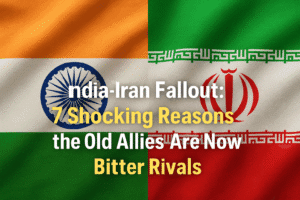The once-warm relationship between India and Iran, forged in the fires of shared nuclear defiance against Western pressure, now lies fractured. The catalyst? Not just geopolitics, but a fundamental clash of ideologies and visions for the world – with Israel standing squarely in the middle. This isn’t merely a policy shift; it’s the unraveling of an alliance built on common resistance, revealing deeper truths about how values ultimately shape national destinies.
The Foundation: United Against the Nuclear Order
For decades, India and Iran found common ground as outliers challenging a non-proliferation regime dominated by the established nuclear powers (NPT signatories like the US, Russia, China, France, and the UK).
- India’s Path: Defiantly pursued nuclear capability outside the NPT framework, culminating in its 1998 tests. Faced international sanctions but leveraged its democratic credentials, economic potential, and strategic position to eventually gain de facto acceptance and a landmark civil nuclear deal with the US.
- Iran’s Path: Initially pursued nuclear technology under the NPT, but faced intense suspicion and crippling sanctions over alleged weaponization intentions. Positioned itself as resisting Western hypocrisy and double standards, arguing its right to peaceful technology was being denied unfairly, unlike countries like India or Israel.
This shared experience of being sanctioned, scrutinized, and labeled “rogue” created a powerful bond. India relied on Iranian oil, and both nations explored avenues like the North-South Transport Corridor to bypass Western-controlled chokepoints.
The Great Divergence: Ideology, Terrorism, and the Shadow of Israel
The cracks began to show not over nuclear technology itself, but over what the two nations chose to do with their geopolitical positions and whom they aligned with:
- The Democracy-Theocracy Divide: India, despite its complex challenges, anchors its identity as the world’s largest democracy. Iran evolved into a revolutionary Islamic theocracy. This fundamental difference in governance and societal values became increasingly difficult to reconcile, especially as Iran’s regional ambitions grew.
- Terrorism as a Red Line: India’s zero-tolerance policy towards terrorism, fueled by devastating attacks linked to Pakistan-based groups, collided head-on with Iran’s robust support for proxy forces like Hezbollah and Hamas. For India, Iran’s patronage of groups using violence against civilians became anathema to its core security interests and values.
- The Israel Factor: This is the most potent wedge. India’s relationship with Israel has transformed into a vital strategic partnership encompassing defense, technology, agriculture, and counter-terrorism. Iran, conversely, defines itself by its vehement opposition to Israel’s existence. India’s deepening ties with Tel Aviv are viewed in Tehran not just as a policy choice, but as a profound ideological betrayal. The recent Israel-Iran conflict only solidified this divide, with India’s measured stance seen as tacitly favoring Israel.
Beyond Ambiguity: India’s Calculated Choice
The article rightly notes that all nuclear powers navigated “strategic ambiguity.” But India’s journey diverges sharply from Iran’s current predicament. India achieved its nuclear status and then integrated itself into the broader international order, trading defiance for strategic partnerships. Its democratic framework, however imperfect, provided a bridge for engagement with the West.
Iran, under its theocratic leadership, remains largely isolated. Its revolutionary ideology, support for proxies, and existential threat rhetoric towards Israel render it incapable of making a similar transition, regardless of the state of its nuclear program post-conflict. The “pariah” status stems not solely from nuclear ambitions, but from actions and ideology perceived as fundamentally destabilizing by a powerful international coalition.
The Human Insight: Values Trump Shared Grievances
The story of India and Iran offers a crucial lesson: shared resistance against a perceived unfair system is a fragile foundation for lasting partnership. When core values – like the acceptance of democratic norms, the rejection of terrorism targeting civilians, and the willingness to engage pragmatically with key international players (including Israel) – fundamentally clash, the alliance crumbles.
India’s choice reflects a pragmatic calculation: aligning with democracies and technological powerhouses (like Israel and the US) offers greater long-term security and economic benefit than clinging to an ideologically rigid, isolated Iran, despite historical ties and energy needs. Iran, bound by its revolutionary identity, sees no such option.
The Lingering Question
The tragedy highlighted in the article isn’t just that Iran was denied the path India took; it’s that Iran’s own choices, driven by its ideology and actions, made that path virtually impossible. The divergence between these two ancient civilizations underscores a harsh reality of modern geopolitics: in an increasingly polarized world, shared grievances are often weaker glue than shared values. The bomb brought them together; everything else has driven them apart. The future of this relationship now seems less about nuclear defiance and more about which vision of the world – democratic engagement or revolutionary resistance – will define the emerging global order.

You must be logged in to post a comment.